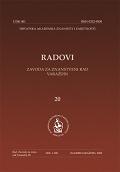Dvije kripte iz Crkve svetog Martina Biskupa u Varaždinskim Toplicama
Two crypts from the Church of Bishop St. Martin in Varaždinske Toplice
Author(s): Spomenka VlahovićSubject(s): Christian Theology and Religion, Archaeology, Architecture, 18th Century
Published by: Hrvatska akademija znanosti i umjetnosti - Zavod za znanstveni rad Varaždin
Keywords: crypt; method of construction; architectural appearance; archaeological finds (coffins, sepulchral ornamentations; texts and artistic decorations);
Summary/Abstract: While carrying out work in 2013 for the renovation of the interior of the Church of Bishop St. Martin in Varaždinske Toplice, and during the work to dismantle an old stone slab, valuable archaeological data in part of the main sanctuary and the side-chapel was discovered. As stated in the title of this work, we present the findings on two crypts from this church. Since little has been written until now on this topic, and it also represents a rarity in the professional literature, we are providing the most recent data, which will probably interest the profession and, we assume, a wider circle of readers. During the archaeological inspection, it was established that the opened crypt was built of stone with a beautifully shaped arch and an earthen floor. A high degree of moisture could be felt in the air, which also had an effect on the condition of the wooden coffins, sepulchral ornamentations, artistic decorations, etc. that were revealed. It was established that the coffins in the interior were divided into two groups. One group (on the left side) was comprised of coffins in which the deceased men and women were lay people, which can be concluded from the partially preserved clothing, and who were probably members of the wealthier social class. Based on the degree of preservation of the hair and the hairstyles it was possible to determine if they were male or female. The second group was comprised of deceased buried in wooden coffins who were identified as members of the church based on the preserved clothing (robes). In addition to these groups of coffins, there is also a partitioned area of the crypt of sufficient size for the burial of one coffin. We are assuming that Isidor Hochreiter is buried here. Hochreiter was a senior church official and a canon of the Zagreb metropolitan see who was born on 10 December 1784 and died at “Jaziška Toplica” on 28 August 1858. We corroborated this assumption by the panel above the tomb that is located above the crypt of the side-chapel of Our Lady of Sorrows. From the text on the panel we learn that the friars Ambrosius and Bartholomew had this tomb monument (a relief panel) installed, and from the signature that is legible on the panel we are assuming that it is the work of Master Hanke of Graz. In addition to information written in Croatian that is legible on wooden fragments of the coffins of two women, one can read 1848 and 1859, which leads us to the connection with the panel above the tomb of Isidor Hochreiter and the year of his death. The work is analogous to conservation-restoration works being carried out at the Church of St. Mark in Zagreb and in the Cathedral of St. Theresa of Ávila in Požega. By this analysis, we succeeded in identifying the many similarities in the archaeological finds of the three sacral buildings, but we were also able to establish their differences
Journal: Radovi Zavoda za znanstveni rad Varaždin
- Issue Year: 2014
- Issue No: 25
- Page Range: 451-477
- Page Count: 27
- Language: Croatian

